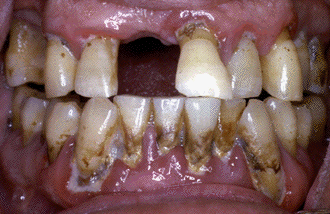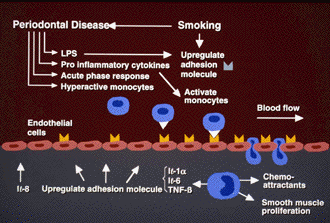by HeartHawk
Sunday, January 04, 2009 For years there have been hints and hypotheses that heart disease and periodontal (gum) disease are associated or share common factors. Among the more humorous notions held by the uninformed press and public was that heart plaque and tooth plaque were somehow the same thing. That dubious notion notwithstanding there have long been provocative findings that have pointed to a relationship between a healthy mouth and a healthy heart.
The first and most widely studied theory was that the bacteria associated with periodontal disease (most notably Porphyromonas gingivalis) somehow traveled through the blood stream and provoked an inflammation response in the heart. Indeed, one of the first large studies (9760 participants over 17 years) found that “those with periodontitis had a 25% increased risk of coronary heart disease relative to those with minimal periodontal disease.” The link became even closer when a subsequent study determined that treating gum disease resulted in improved endothelial function and blood flow. Since then there have been numerous other studies that have detected a statistically significant association between gum disease and a variety of biomarkers for heart disease such as C-Reactive Protein (CRP) and Lipoprotein-associated Phospholipase A2 (Lp-PLA2).
One of the first direct links between periodontal and heart disease was found in a study that determined those with chronic periodontitis had higher triglyceride levels and a greater prevalence of small LDL a particularly powerful promoter of heart disease even among people with low cholesterol. The problem with these and many other studies is that it is often difficult to determine whether these similar biomarkers actually cause the disease or whether they are simply common indicators of a disease whose cause is some other common factor.
It could be that people without gum and/or heart disease simply live healthier, exercise, eat better, etc., than those with either or both diseases! However, for the first time, a study has shown that treating even mild gum disease in otherwise healthy people not only improves endothelial function but significantly reduces carotid intima media thickness (CIMT). That’s right, they found unequivocal evidence that treating gum disease regresses a standard measure of atherosclerosis.
To be fair, the study only looked at carotid arteries and not coronary arteries, it was a fairly small study (just 35 people), and CIMT is among these easiest markers of atherosclerotic lesions to regress. Head researcher Dr. Mario Clerici is quoted as stating, “The novelty ofthis study is that this is the first physical evidence that you can reverse a lesion that is already growing in the intima by doing something as simple as taking care of your gums . . . To tell you the truth, we were really surprised by the result, but it turned up in subject after subject.” The study involved nothing more than the simple removal of tartar and cleaning of the gums. There were no other procedures, no antibiotics or other prescription drugs or supplements, just the same basic dental hygiene measures you might receive at your dentist’s office.
Researchers used Echocardiography of carotid arteries to compare baseline CIMT against measurements made at several time points after treatment. They also measured common inflammatory biomarkers associated with cardiovascular risk. The study treatments resulted in significant reductions in CIMT at multiple sites as well as reductions in bacterial load and of the inflammation biomarkers. For the record, there is still much to be learned about the connection between heart disease and dental health. To recap the study was small, it only looked at carotid arteries not coronary arteries, and CIMT is perhaps the easiest atherosclerosis marker to regress. Nonetheless, we have the first solid evidence that there IS a connection between heart health and dental health. The takeaway heart health hint here is that you have another reason to follow the age-old admonition to visit your dentist regularly for a cleaning and check-up. You will now have two reasons to smile – whiter teeth and a potentially healthier heart.
The host’s reaction to foreign bodies known as an inflammatory response plays an important role in the etiology of cardiovascular disease. The physician is able to monitor this response by the serum levels of a blood protein called C-reactive protein or CRP. CRP levels in the blood have been shown to be predictive of a heart attack. In January of 2005 two papers were published that showed that if the blood levels of CRP were reduced, in these studies by prescription drugs known as statins, that the incidence of heart attacks were significantly decreased.
These studies indicate that the serum levels of CRP are an independent and modifiable risk factor for cardiovascular disease. But no one is quite sure what are the factors or conditions that cause the levels of CRP to increase in the blood. In most cases there are no acute infections or processes that can be associated with the elevated levels, leaving one to wonder what chronic, presumably asymptomatic condition is contributing to the high levels. In this context there is an emerging literature that suggests that dental infections, especially periodontal disease, could be playing a role. The connection is based on several observations that, while biologically plausible, lack the scientific rigor of a proven fact.
Could this man’s periodontal infection be a risk factor for cardiovascular disease?

In 1989 several cardiologists from Finland, i.e., Matilla, Syrjanen and their colleagues, reported that poor dental health could be associated with both an acute myocardial infarction and with a cerebral vascular accident. Subsequently, in a 7-year prospective study, dental disease as measured by the Total Dental Index (p=0.007), the number of previous myocardial infarctions (p=0.003), and to a lesser extent, diabetes (p=0.06), were associated with a risk of developing a new and often fatal myocardial infarction. Traditional risk factors, such as hypertension, smoking, total cholesterol levels, HDL cholesterol levels, triglycerides, social-economic status, gender and age were not significant predictors of a coronary event, when included in a model that contained the dental variables.
Other studies have generally confirmed this link between dental disease and coronary heart disease. A prospective cohort design study, involving data from 9,760 United States males examined three times between 1971 and 1987, found a significant relationship between either periodontitis or edentulism and coronary heart disease, even after adjusting for 13 known risk factors. A representative sample of 1,384 adult Finnish males, aged 45-64 years, showed that the number of missing teeth, along with hypertension, geographic area, and educational level were independent explanatory factors for the presence of ischemic heart disease. Among United States veterans participating in a longitudinal aging study, a significant association between periodontal disease, as measured by the extent of alveolar bone loss, and coronary heart disease and stroke could be demonstrated after adjusting for various cardiovascular risk factors.
We have been recording a large number of oral/dental variables in a group of elderly veterans, so as to study the relationship between oral/dental health and systemic diseases among older individuals. We found that a statistical association exists between a diagnosis of coronary heart disease and certain oral/dental parameters such as the numbers of missing teeth, plaque BANA test scores, salivary levels of certain bacteria and complaints of dry mouth or xerostomia. In logistic regression models, dentate individuals with 1 to 14 teeth were 2.81 times more likely to have coronary heart disease than individuals with most of their teeth, i.e., 15 to 28 teeth. A positive plaque BANA score, which indicates the presence of certain anaerobic bacteria in the plaque samples, was twice as likely to be found in dentate individuals with coronary heart disease, compared to dentate individuals without coronary heart disease. Individuals who complained of a dry mouth were 2.34 times more likely to have a diagnosis of coronary heart disease.
The dental/oral variables in these older individuals were more strongly associated with coronary heart disease than were recognized risk factors such as serum cholesterol levels, the body mass index and smoking status. This suggests that good dental health may be important in maintaining good cardiovascular health.
How could an inflammation about the gums cause disease on the linings of the arteries? Good question, as it is difficult to see how events occurring on the teeth or in the gum tissue could influence the development of an atheroma on the endothelial surface of arteries such as the coronary artery. A new paradigm is appearing in medicine that asks “are all diseases infections? This possibility was suggested by the demonstration that most ulcers are due to a treatable infection with Helicobacter pylori, and has been fueled in recent years by the association of chronic infections with cerebral and myocardial infarctions. Dental infections were not considered as contributory to these events, even though dental caries and periodontal disease are the most common of all chronic infections. It is well known that dental treatments, and dental infections can cause a bacteremia, and that this bacteremia has been associated with infective endocarditis.
Dental infections, involving the soft tissues of the periodontium and the pulp, can also elicit an inflammatory response that could release into the systemic circulation a variety of biologically active molecules. These bacterial products, such as lipopolysaccharides (LPS) and heat shock proteins (HSP), as well as inflammatory mediators such as cytokines, could directly or indirectly influence events on the intima of blood vessels. It is this propensity of dental infections to raise the white blood cell counts, to elicit a chronic inflammatory response, and/or an asymptomatic bacteremia, that will link dental disease with cardiovascular disease.
In the illustration shown below, smoking, which is a risk factor for both cardiovascular disease and periodontal infections, is shown to directly increase (upregulate) the number of adhesion molecules on the lining of endothelial cells. These adhesion molecules allow activated monocytes to attach to the lining of blood vessels and squeeze between the endothelial cells, causing an inflammatory response in the tissue below the endothelial cells. Smoking, however, promotes periodontal infections, which in turn releases LPS (lipopolysaccharide) molecules into the blood stream and these LPS molecules can also upregulate adhesion molecules. Other aspects of the inflammation in the gum tissues can also increase the blood levels of pro-inflammatory cytokines and acute phase proteins like the C-reactive proteins. The inflammation in the gum tissues can activate those monocytes which are capable of sticking to the adhesion molecules, which in turn can squeeze between the endothelial cells becoming tissue macrophages.

Several chronic infections can follow this pathway of upregulating adhesion molecules and activating monocytes. The best known of these are respiratory infections due to Chlamydia pneumonia. Dental infections, however, are far more common than C. pneumonia infections and are usually asymptomatic. The man whose periodontal infection is shown below had no symptoms and came to the dental clinic seeking a replacement for his missing front tooth. He was oblivious to his periodontal condition, even though there was bleeding and inflammation around most of his teeth. Based upon recent studies, if we had taken a blood sample of this man, the levels of known risk factors for atherosclerosis (white blood cell count, C-reactive protein level, HDL-cholesterol level and fibrinogen level) would all be higher than those in a comparably aged man without periodontal disease. It is the extent and pervasiveness of the periodontal infection that would make this a possible risk factor for cardiovascular disease.

If periodontal inflammation is shown to be a risk factor for either coronary artery disease or stroke (see Dental Disease and Cerebral Vascular Disease), then it will be considered a modifiable risk factor, since it can be treated. This means that the dentist and the patient will both be concerned with periodontal disease and the available treatment choices. (See Antimicrobial Agents in Periodontal Disease).
from Walter Loesche: http://www.dent.umich.edu/research/loeschelabs/